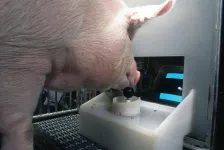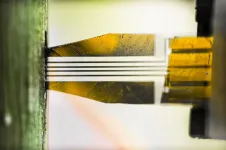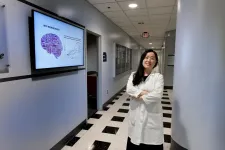(Press-News.org) DALLAS - Feb. 11, 2021 - A study led by UT Southwestern has identified a mechanism that controls the activity of proteins known as chaperones, which guide proteins to fold into the right shapes. The findings, published online today in Nature Communications, could shed light on hundreds of degenerative and neurodegenerative diseases caused by protein misfolding, such as Alzheimer's, Parkinson's, and Huntington's, potentially leading to new treatments for these devastating conditions.
Every protein in the body is originally produced in a linear chain, with amino acid building blocks strung together one after another. But to fulfill their roles in cells, explains study leader Lukasz Joachimiak, Ph.D., assistant professor in the Center for Alzheimer's and Neurodegenerative Diseases at UT Southwestern, these chains need to fold into precise shapes. Chaperones help proteins accomplish this by protecting their vulnerable portions while they shift into position and steering them to adopt the proper shape.
Every cell has a variety of chaperones that recognize and act on individual protein types. However, every chaperone isn't active all the time, Joachimiak says. Unknown regulatory mechanisms appear to control when certain chaperones step in to guide their respective proteins to fold and when they stand aside.
Joachimiak, also a member of the Peter O'Donnell Jr. Brain Institute, and his colleagues studied a family of chaperone proteins known as Hsp40s that work in combination with other chaperones known as Hsp70s. Members of these co-chaperones are involved in the proper folding of many proteins, including tau, which play a key role in causing Alzheimer's disease when it's misfolded.
Hsp40 chaperones bind to Hsp70s through a specific portion on the Hsp40s called the J domain. But how the Hsp40s turn off this binding when it is not needed has been unclear.
To help answer this question, Joachimiak and his colleagues used a specific Hsp40 called DnaJB8 as a model. When the researchers genetically modified these proteins to glow green inside cells, they found that they didn't just exist as individual, free-floating units - the DnaJB8 chaperones tended to form aggregates, suggesting they had some way to stick to each other. They retained this ability to agglomerate when they were isolated in petri dishes.
Using computer modeling and guided by biochemical experiments, the researchers discovered that two separate parts of this chaperone were drawn to each other through a type of chemistry called electrostatic interactions: Part of the J domain was drawn to a different part of this protein called the C-terminal domain through charged interactions. Modeling also showed that the J domain and the C-terminal domain stuck together on single molecules as well.
Joachimiak and his team validated these findings on real DnaJB8 proteins using a technique called solid-state nuclear magnetic resonance. They also showed that the J and C-terminal domains stuck to each other when they were isolated from the full DnaJB8 molecule.
The researchers suspected that the interaction between these two domains could prevent DnaJB8 from binding to its co-chaperone, an Hsp70, preventing them from jointly doing their job of guiding protein folding. Sure enough, experiments showed that the C-terminal domain of DnaJB8 competed with an Hsp70 called HspA1A when it was added to DnaJB8 in a test tube, blocking HspA1A from binding to the J domain when the C-terminal domain was bound instead.
Joachimiak notes that something may go awry in this or other regulatory mechanisms that control the activity of chaperones in protein misfolding diseases. Finding ways to control this activity through pharmaceuticals or other means could provide a new way to treat these conditions to attack the problem at its source.
"We may be able to leverage this mechanism to directly target these chaperones, activating them at will," says Joachimiak, who is also an assistant professor of biochemistry and an Effie Marie Cain Scholar in Medical Research. "Our results could have an impact on hundreds of diseases where proteins become bad players by misfolding."
INFORMATION:
Other UT Southwestern researchers who contributed to this study include Bryan D. Ryder, Sofia Bali, and Jaime Vaquer-Alicea.
This work was supported by a grant from The Welch Foundation (I-1928-20170325).
About UT Southwestern Medical Center
UT Southwestern, one of the premier academic medical centers in the nation, integrates pioneering biomedical research with exceptional clinical care and education. The institution's faculty has received six Nobel Prizes, and includes 23 members of the National Academy of Sciences, 17 members of the National Academy of Medicine, and 13 Howard Hughes Medical Institute Investigators. The full-time faculty of more than 2,500 is responsible for groundbreaking medical advances and is committed to translating science-driven research quickly to new clinical treatments. UT Southwestern physicians provide care in about 80 specialties to more than 105,000 hospitalized patients, nearly 370,000 emergency room cases, and oversee approximately 3 million outpatient visits a year.
DALLAS, February 11, 2021 -- Structural racism is a public health crisis in the U.S. and worldwide. The scientific publishing community can improve our understanding and address the significant health impacts of structural racism in racial and ethnic disparities research, according to a new statement, "The Groundwater of Racial and Ethnic Disparities Research: A Statement from Circulation: Cardiovascular Quality and Outcomes," published today in Circulation: Cardiovascular Quality and Outcomes, an American Heart Association journal, from the journal's editors.
It is critical to acknowledge the societal structures - the groundwater, as it is called in "The Groundwater Approach: Building ...
HIV self-testing could reduce the time between HIV infection and HIV diagnosis amongst trans people when compared to standard testing services, suggests new research in EClinicalMedicine.
The project was a collaboration between the London School of Hygiene & Tropical Medicine (LSHTM), University College London (UCL), and the Medical Research Council Clinical Trials Unit. It involved more than 100 trans men and trans women in England and Wales, and is the largest HIV self-testing trial in this community to be reported.
Participants were first randomised into two groups, ...
Variants of nine genes increase the risk of developing Addison's disease, a rare disease in which the immune system attacks the adrenal glands. That is according to the largest genetic study to date on patients with Addison's disease. The findings help increase knowledge about what causes the disease. The study was conducted by researchers at Karolinska Institutet, Sweden, and Bergen University, Norway, and is published in the journal Nature Communications.
"By studying the single largest collection of samples from patients with Addison's disease, we've been able to carry out the first genetic ...
The strange social structure of tiny fish called emerald coral gobies may be explained by family loyalty, new research shows.
Coral goby groups contain a single breeding male and female and - as "sequential hermaphrodites" - the subordinate gobies can take over either role if one of the breeders dies.
The puzzle for biologists is why breeders tolerate the smaller non-breeders sharing their space and competing for food.
One explanation is "kin selection" (favouring related individuals).
Reef fish are often assumed to disperse at random after hatching, meaning groups of adults should not be closely related, but the new study finds "positive relatedness" ...
Pigs will probably never be able to fly, but new research is revealing that some species within the genus Sus may possess a remarkable level of behavioral and mental flexibility. A study published in END ...
Peer reviewed / Review and opinion
First comprehensive assessment of damage to health inflicted by former President Trump cites decades of policy failures made worse by the Trump administration, resulting in 461,000 unnecessary US deaths annually before the COVID-19 pandemic, and tens of thousands of unnecessary COVID-19 and pollution-related deaths attributable to his actions.
Lancet Commission calls for immediate rollback of Trump's health-harming policies and additional sweeping reforms to reverse the deteriorating health of the US population: "The path away from Trump's politics of anger and despair cannot lead through past policies."
The first comprehensive assessment of the health effects of Donald Trump's presidency is published today ...
Researchers at Linköping University, Sweden, have developed biosensors that make it possible to monitor sugar levels in real time deep in the plant tissues - something that has previously been impossible. The information from the sensors may help agriculture to adapt production as the world faces climate change. The results have been published in the scientific journal iScience.
The primary source of nutrition for most of the Earth's population is mainly plants, which are also the foundation of the complete ecosystem on which we all depend. Global population ...
A tiny population of neurons known to be important to appetite appear to also have a significant role in depression that results from unpredictable, chronic stress, scientists say.
These AgRP neurons reside exclusively in the bottom portion of the hypothalamus called the arcuate nucleus, or ARC, and are known to be important to energy homeostasis in the body as well prompting us to pick up a fork when we are hungry and see food.
Now Medical College of Georgia scientists and their colleagues report the first evidence that, not short-term stress, like a series of tough college exams, rather chronic, unpredictable stress like that which erupts in our personal and professional lives, induces changes in the function of AgRP neurons that may contribute to depression, they ...
Researchers from University of Amsterdam and Stanford University published a new paper in the Journal of Marketing that examines explores how human-as-machine representations affect consumers--specifically their eating behavior and health.
The study, forthcoming in the Journal of Marketing, is titled "Portraying Humans as Machines to Promote Health: Unintended Risks, Mechanisms, and Solutions" and is authored by Andrea Weihrauch and Szu-Chi Huang.
To combat obesity, governments, marketers, and consumer welfare organizations often encourage consumers ...
Obesity and excess body fat may have contributed to more deaths in England and Scotland than smoking since 2014, according to research published in the open access journal BMC Public Health.
Between 2003 and 2017 the percentage of deaths attributable to smoking are calculated to have decreased from 23.1% to 19.4% while deaths attributable to obesity and excess body fat are calculated to have increased from 17.9% to 23.1%. The authors estimate that deaths attributable to obesity and excess body fat overtook those attributable to smoking in 2014.
Jill Pell, at the University of Glasgow, United Kingdom, the corresponding author said: "For several decades smoking has been a major target of public ...





